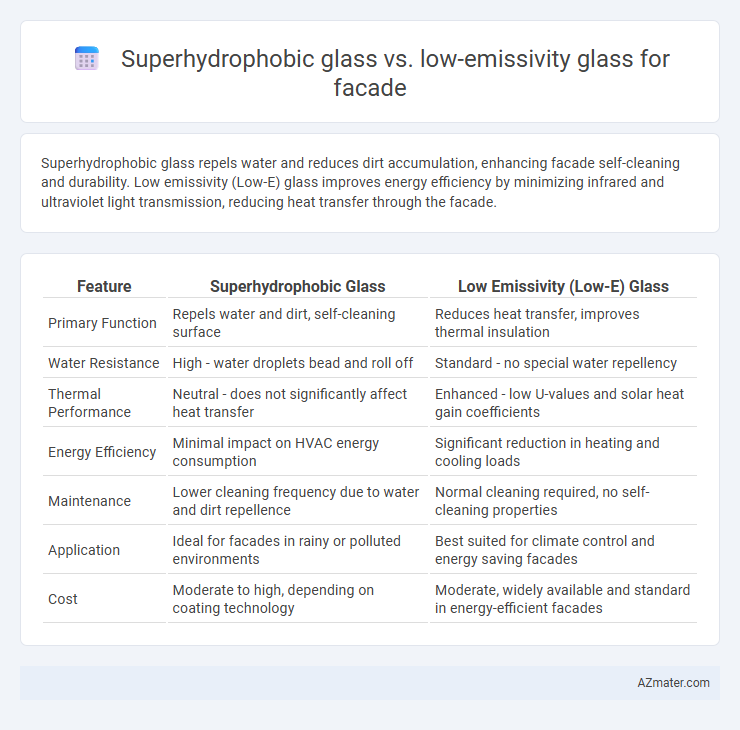Superhydrophobic glass repels water and reduces dirt accumulation, enhancing facade self-cleaning and durability. Low emissivity (Low-E) glass improves energy efficiency by minimizing infrared and ultraviolet light transmission, reducing heat transfer through the facade.
Table of Comparison
| Feature | Superhydrophobic Glass | Low Emissivity (Low-E) Glass |
|---|---|---|
| Primary Function | Repels water and dirt, self-cleaning surface | Reduces heat transfer, improves thermal insulation |
| Water Resistance | High - water droplets bead and roll off | Standard - no special water repellency |
| Thermal Performance | Neutral - does not significantly affect heat transfer | Enhanced - low U-values and solar heat gain coefficients |
| Energy Efficiency | Minimal impact on HVAC energy consumption | Significant reduction in heating and cooling loads |
| Maintenance | Lower cleaning frequency due to water and dirt repellence | Normal cleaning required, no self-cleaning properties |
| Application | Ideal for facades in rainy or polluted environments | Best suited for climate control and energy saving facades |
| Cost | Moderate to high, depending on coating technology | Moderate, widely available and standard in energy-efficient facades |
Introduction to Facade Glass Technologies
Superhydrophobic glass features a nanoscale textured surface that repels water and dirt, reducing maintenance needs and enhancing durability for building facades. Low emissivity (Low-E) glass incorporates a microscopically thin metallic coating that minimizes infrared and ultraviolet light transmission, improving energy efficiency by controlling heat transfer. Both technologies serve distinct functions in facade design, with superhydrophobic glass prioritizing self-cleaning properties and Low-E glass focusing on thermal insulation and energy conservation.
What is Superhydrophobic Glass?
Superhydrophobic glass features a nanostructured surface coating that repels water, preventing droplets from adhering and promoting self-cleaning properties for building facades. This technology enhances durability by reducing dirt accumulation and water damage, resulting in clearer, maintenance-free glass over time. In contrast, low emissivity glass primarily focuses on thermal insulation by minimizing infrared heat transfer, improving energy efficiency without offering the water-repellent benefits of superhydrophobic glass.
Key Features of Low Emissivity (Low-E) Glass
Low Emissivity (Low-E) glass features a microscopically thin metal coating that reflects infrared energy while allowing visible light to pass through, enhancing thermal insulation in facades. This glass significantly reduces heat transfer, improving energy efficiency by keeping interiors cooler in summer and warmer in winter. Its ability to block UV rays helps protect interior furnishings from fading, making it an essential component in sustainable building design.
Mechanisms Behind Superhydrophobic vs Low-E Performance
Superhydrophobic glass leverages nanostructured surface coatings to create micro- and nanoscale roughness combined with low surface energy materials, enabling water droplets to bead and roll off, thus maintaining transparency and cleanliness. Low emissivity (Low-E) glass utilizes thin metallic oxide layers that selectively reflect infrared radiation while transmitting visible light, significantly reducing heat transfer through facades and enhancing energy efficiency. The primary mechanism difference lies in superhydrophobic glass focusing on water repellency through physical surface texture modification, whereas Low-E glass centers on electromagnetic spectrum control via optical interference.
Energy Efficiency Comparison: Superhydrophobic vs Low-E Glass
Superhydrophobic glass enhances facade energy efficiency by repelling water and dirt, reducing maintenance and ensuring consistent solar control properties. Low emissivity (Low-E) glass significantly improves thermal insulation by reflecting infrared radiation, thereby reducing heating and cooling energy consumption in buildings. While superhydrophobic coatings contribute to longevity and surface cleanliness, Low-E glass offers superior energy savings through optimized thermal performance on facades.
Durability and Maintenance: Which Glass is Superior?
Superhydrophobic glass offers exceptional durability by resisting water, dirt, and contaminants, reducing maintenance frequency and preventing surface degradation over time. Low emissivity (Low-E) glass enhances energy efficiency by minimizing heat transfer but requires careful cleaning to maintain its coating integrity, which can be prone to scratches and damage. Therefore, superhydrophobic glass generally surpasses Low-E glass in long-term durability and low-maintenance performance for facade applications.
Aesthetic and Visual Considerations for Building Facades
Superhydrophobic glass offers superior water repellency, maintaining a clearer and cleaner appearance on facades by minimizing water stains and dirt accumulation, enhancing long-term visual appeal. Low emissivity (Low-E) glass, designed primarily for energy efficiency, may sometimes exhibit a slight tint or reflectivity that affects the facade's color consistency and visual transparency. For aesthetic considerations, superhydrophobic glass preserves natural clarity and brightness, while Low-E glass balances energy performance with subtle visual modifications that influence facade light transmission and reflection.
Cost Analysis: Installation and Long-Term Value
Superhydrophobic glass offers advanced water-repellent properties that reduce maintenance costs by preventing dirt accumulation, but its installation costs can be higher due to specialized coatings and technologies. Low emissivity (Low-E) glass, while generally more affordable to install, provides superior energy efficiency by minimizing heat transfer, leading to significant long-term savings on heating and cooling expenses. When evaluating facade solutions, initial investment in superhydrophobic glass must be weighed against its maintenance benefits, whereas Low-E glass offers clear economic advantages through energy performance and reduced utility bills.
Environmental Impact and Sustainability
Superhydrophobic glass, which repels water and resists dirt accumulation, reduces maintenance frequency and water usage, enhancing its environmental sustainability for building facades. Low emissivity (Low-E) glass minimizes heat transfer by reflecting infrared radiation, significantly improving energy efficiency and reducing HVAC-related carbon emissions. Integrating superhydrophobic and Low-E glass technologies in facades promotes sustainable building performance by combining reduced energy consumption with lower water and chemical cleaning requirements.
Choosing the Right Glass for Your Facade: Final Recommendations
Superhydrophobic glass offers superior water repellency and self-cleaning properties, reducing maintenance costs and improving facade durability, making it ideal for environments with frequent rain or pollution. Low emissivity (Low-E) glass excels in thermal performance by minimizing heat transfer, enhancing energy efficiency, and maintaining indoor comfort in both hot and cold climates. For facades requiring both minimal maintenance and energy efficiency, a combination of superhydrophobic coating on Low-E glass provides an optimal balance of durability, sustainability, and cost-effectiveness.

Infographic: Superhydrophobic glass vs Low emissivity glass for Facade
 azmater.com
azmater.com